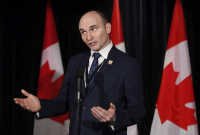Support strong Canadian climate journalism for 2025
International Monetary Fund researchers say the federal government can afford to spend $8 billion annually to reduce the cost of child care spaces nationwide because the program would pay for itself.
The proposal is more than 10 times what the Liberals have promised to spend annually over the next decade on child care.
The IMF predicts the cash would bring down the national average for child care fees by about 40 per cent, a figure expected to be high enough that it could entice more women into the workforce and drive greater economic growth.
By the organization's estimates, there are about 150,000 highly-educated women who are stay-at-home parents.
If they all entered the workforce and started paying taxes, the IMF says, they would boost economic growth by two percentage points, equal to about $8 billion more in federal income tax revenue — enough to cover the cost of the program.
But the IMF adds a caveat to the proposal: It should be conditional on employment so that highly-educated mothers are prodded into the workforce.
A spokeswoman for Social Development Minister Jean-Yves Duclos said the government's commitment of $7.5 billion over 11 years towards child care would increase women's labour market participation.
"When quality educational child care services are affordable, parents — particularly women — can more easily participate in the labour market and invest in their careers. Taking gender equality seriously means taking child care services seriously, and our government will continue to work on improving gender equality," Emilie Gauduchon-Campbell said.
"Canada succeeds when women and girls are given opportunities to succeed."
The Liberals' economic growth council, which met with IMF researchers as part of the study, recommended in a February, pre-budget report that the government consider creating a national child care program to boost productivity by getting more women, particularly those with younger children, into the workforce.
Maternal labour force participation rates have risen in recent decades, but the IMF report notes there remains a gender gap in participation and wages — one that isn't as wide in Quebec where there is a subsidized system.
The Liberals unveiled their child care proposal in this year's budget, pledging $7.5 billion over 11 years, beginning with $500 million this year and increasing to $870 million annually by 2026 in order to fund spaces — or improvements — in provinces and territories.
The money could potentially create 40,000 subsidized spaces over the next three years at a cost of $1.3 billion.
The federal government has to sign funding agreements with provinces and territories before the money can flow.
A key step in that process took place last month when Duclos and his provincial and territorial counterparts signed a national framework that sets the goals for federal child care spending. At the time, Duclos hinted that the deal could one day lead to a national system similar to the one in Quebec.
But the IMF also believes the Liberals' signature Canada Child Benefit might be having the opposite effect on women in the workforce.
The $23-billion-a-year benefit is worth up to $6,400 annually for a child under six, and up to $5,400 a year for children six to 17. The benefit is income tested, meaning that the less a family earns, the more it receives in benefits per child.
The IMF says the benefit doesn't provide incentives for parents to work or get job training.
The effect on low-income families may be the largest, with the IMF team calculating that they would see their finances worsen if both parents work due as a result of a reduction in the child benefit, increases in taxes, and covering the high cost of child care. Middle- and high-income families see their finances improve or not change at all if both parents work, the report says.
Gauduchon-Campbell said the Liberals introduced the benefit to help more women and girls. She said the government also intends to introduce pay equity legislation next year.





Comments